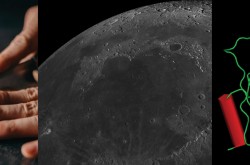3 things you should know about beets, satellites, and robotic surgery

Meet Renée-Claude Goulet, Cassandra Marion, and Michelle Campbell Mekarski.
They are Ingenium’s science advisors, providing expert scientific advice on key subjects relating to the Canada Agriculture and Food Museum, the Canada Aviation and Space Museum, and the Canada Science and Technology Museum.
In this colourful monthly blog series, Ingenium’s science advisors offer up quirky nuggets related to their areas of expertise. For the February edition, they delve into a promising solution for combatting slippery winter roads, how satellites are improving our ability to monitor and study volcanoes, and why robotics may play an increasing role in medical surgeries.

A new way to “beet” slippery winter roads
Canadians are familiar with the wintry ritual of spreading de-icing salt on walkways and roads, to keep them from getting too slippery. Though it's effective for preventing falls and accidents, there are many drawbacks to road salt. Beyond staining our boots and rusting our cars and bikes, salty water can cause serious environmental degradation. Now, in an effort to reduce their use of salt, some Canadian cities have started using beet molasses — a by-product of the sugar refining industry — to boost salt's de-icing power.
Our table sugar, also known as sucrose, mainly comes from sugar cane and sugar beets. Much larger than the garden variety beets some of us love to eat, sugar beets are white in colour. To extract the sugar, processors mash up the beets to make juice, which is then thickened through evaporation. As the liquid becomes more concentrated, the sugar crystalizes and can be collected. The leftover pulp becomes pelleted animal feed, while the beet molasses (the final syrup with most of its sugar extracted) can become the magic ingredient to make road salt more effective.
Calcium chloride, or road salt, is effective in temperatures down to -10 C, and becomes ineffective below -20 C. But by pre-wetting the salt with diluted beet molasses, the mixture will work to about -32 C. A pre-application of beet fluid also helps salt stick to the road longer, reducing salt bounce and runoff. While it is about three times more expensive than road salt, the higher efficacy and reduced need for reapplication cuts the costs of labour, fuel for trucks, and salt. Due to the high cost of the beet juice solution, those cities testing it currently reserve it for higher-risk areas that freeze up more easily, such as bridges and overpasses.
This new application for a food by-product shows promise for reducing the environmental impact of our de-icing operations. However, research efforts are still ongoing to determine whether this substance has any unintended environmental effects, such as affecting the aquatic food chain. If beet molasses proves to be viable on the environmental side — and if a domestic supply can be secured (currently, there is just one sugar beet factory in Canada) — we may see more cities adopt this unexpected ingredient in their de-icing arsenal in the future.
By Renée-Claude Goulet

A still, cropped image of the Hunga Tonga-Hunga Ha’apai volcano’s eruption viewed by the National Oceanic and Atmospheric Administration’s GEOS West satellite on January 15, 2022.
Satellites capture the largest volcanic eruption in 30 years
Two geostationary satellites captured striking, near real-time video of the Hunga Tonga-Hunga Ha’apai volcano’s massive eruption in the last month.
Hunga Tonga and Hunga Ha’apai are islands that were connected by a volcanic crater prior to the recent eruptions. The two islands lie on the rim of a mostly submarine volcano in the Kingdom of Tonga. They are located in the Ring of Fire — a series of volcanos that contour the Pacific Ocean — where the Pacific tectonic plate melts as it plunges into the mantle beneath the Australian plate. The volcano began erupting in December 2021, followed by an explosive eruption on January 13, 2022, then another very explosive, violent eruption on January 15, 2022. Volcanologists suggest this eruption was the most powerful eruption since that of Mount Pinatubo in the Philippines in 1991.
The Hunga Tonga-Hunga Ha’apai eruption resulted in a 500 km-wide umbrella cloud with crescent-shaped bow shock waves, along with gravity waves that propagated around the globe. Bursts of tephra (rock fragments) and volcanic gases spewed from the volcano and a sonic boom was heard as far as Alaska. The plume of ash and smoke rose at least 35 km, generating enough charge to create lightning. The eruption also triggered a tsunami which affected the entire Pacific.
Satellite observations
The variety and increase in the number of Earth observation satellites, as well as advancements in technology, have considerably improved our ability to both monitor and study volcanoes. The National Oceanic and Atmospheric Administration’s GOES-West satellite and Japan’s Himawari-8 weather satellite are in a geostationary orbit. This means they orbit the equator at the same speed as the Earth rotates, at an altitude of about 35,000 km; this enabled them to continuously monitor the same region and capture the unprecedented videos of the massive eruption.
Today, there are more than 200 Earth observation satellites with a range of imaging and analytical capabilities, including low-Earth-orbit constellations that image the Earth every day, such as Canada's RADARSAT constellation, and Planet's Dove and Skysat constellations of satellites. For Hunga Tonga-Hunga Ha’apai and many other active volcanoes worldwide, we’re able to monitor and compare day-to-day changes to the terrain. We can also measure lava flows, track ash cloud movement and changes to the atmosphere, monitor volcanic gases, and evaluate damages. Thankfully, satellites also enable us to better monitor for dangerous eruptions and issue alerts worldwide to get people to safety — as they did for this eruption-related tsunami — and send aid where it’s needed.
Observations from space have given us incredible, new information on which to advance the field of volcanology. However, these images should be combined with research and instruments collecting data on site where possible — to make sure we’re getting the most complete picture.
By Cassandra Marion

Robots may allow doctors to perform complex procedures with more precision than is possible with conventional techniques.
Domo arigato, Dr. Roboto
“Thank you very much, Mr. Roboto…For doing the jobs nobody wants to.”
These renowned lyrics — from the classic 80s hit song, Mr. Roboto by Styx — still ring true today. Humans rely on robots for the tasks that people can’t, shouldn’t, or simply don’t want to do. Robots are very good at performing repetitive tasks, since they don’t get bored, distracted, or slow down. They are also ideal for hazardous or intensive tasks, since they don’t get carpal tunnel syndrome, experience toxicity, or need to take breaks. More precise than humans, robots can perform tasks at a consistent level of speed and accuracy.
As technology improves, robots are also becoming more important and widespread in jobs where there are simply not enough people to accomplish the work that needs doing. In the wake of COVID-19, wait times for surgical procedures have skyrocketed. Imagine if robots could take some of the pressure off health care professionals. As it turns out, that future might not be very far away.
In January 2022, a team from Johns Hopkins University reported that their Smart Tissue Autonomous Robot (STAR) successfully reconnected a severed pig intestine without help from a human. Their STAR performed a procedure called a laparoscopic small-bowel anastomosis. The name helps explain why this particular procedure is so challenging for humans, and such a good candidate for a robotic surgery:
- Laparoscopic: instead of cutting someone wide open to perform a surgical procedure, a laparoscopic surgery is performed through a tiny hole. This means that the surgeon has very little space to move, and can’t directly see what is going on.
- Small-bowel: the surgery is to repair the small intestine. Any mistake could cause a leak in the intestine, which could kill the patient.
- Anastomosis: reconnecting two ends of an intestine is an extremely challenging and repetitive task. As the surgeon sews the intestine together, the stitches must be absolutely precise and consistent — otherwise they could leave a hole in their repair.
Not only did STAR successfully complete the procedure, it did a better job than the human surgeons. This result is exciting and the implications even more so. Robotic surgeons allow doctors to perform delicate and complex procedures that may be difficult or impossible with other methods. Robotic surgery also allows more procedures to be done laparoscopically — leading to fewer patient complications, quicker recovery times, less pain, and shorter wait times.
At this rate, Styx may have to release a new song — in honour of Doctor Roboto.
By Michelle Campbell Mekarski
Enjoying the Ingenium Channel? Help us improve your experience with a short survey!







































